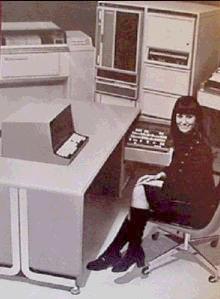



The HP3000 in 1972
Language Iterations
/sec
_______________________
sh.hpbin.
sys script 0.01
CI.PUB.SYS
commandfile 0.10
Cognos
Powerhouse 1.00
MPEX 1.09
Perl 1.20
BASIC/V
Interpreted 1.64
Speedware 2.61
java classic
no jit 12.00
java hotspot
Xint 21.00
gcc
unoptimized 106.00
Pascal(CM) 119.33
Pascal(NM)
(unopt) 130.10
Pascal(NM)
(opt lvl 1) 155.50
c89 unopt 158.00
COBOL(NM)
(unopt) 167.00
COBOL(NM)
(opt lvl 1) 182.00
java classic
jit 194.00
SPL(CM) 197.63
BASIC/V(CM)
(compiled) 199.60
java hotspot
xmixed 288.00
BASIC/V(est)
(compiled,
octcomped) ~300.00
PASCAL(NM)
(opt lvl 2) 379.90
gcc -O3 640.00
gcc -O3
funroll
loops 667.00
c89 opt 702.00
Do not think of "old" as being passe. Rather, because of the era of slow processors and small machines in which BASIC was developed, there are significant advantages to the use BASIC. BASIC/V is:
Further, BASIC/V contains its own internal full-screen editor. And every line of input is syntax-checked as it is entered. Both attributes provide the best, most productive elements of the most modern IDE's (integrated development environments), and they've always been there. |
BASIC/V A simple, rapid applications development language for the HP3000 Because BASIC/V is now a shared source program, BASIC/V is freely available to all HP3000 users, without any further licensing restrictions. You may freely obtain the two necessary files, BASIC and BASICOMP, here. The wrq versions are for Reflection Label transfers. Download the two files and FTP them to the PUB.SYS group of your HP3000. Make sure you use binary transfer with your FTP. ftp> ftp> bin 200 Type set to I. ftp> put basic.prog.bin basic; rec=128,,f,binary;code=PROG 200 PORT command ok. 150 File: basic;rec=128,,f,binary;code=PROG opened; data connection will be opened 226 Transfer complete. ftp: 99584 bytes sent in 0.17Seconds 582.36Kbytes/sec. ftp> put basicomp.prog.bin basicomp; rec=128,,f,binary;code=PROG 200 PORT command ok. 150 File: basicomp;rec=128,,f,binary;code=PROG opened; data connection will be opened 226 Transfer complete. ftp: 73216 bytes sent in 0.22Seconds 335.85Kbytes/sec. ftp>Note: BASIC needs to run from a group with CAP=BA,IA,MR,DS,PH. Group PUB.SYS should have these already. That's it. You're now ready to use BASIC. The following manuals were scanned in as 300dpi, image-only (non-searchable) PDF files. If you wish to recreate the exact look and feel of the original manuals, print the following PDF files using a duplex printer filled with 8.5 x 11" paper. To insure that the manuals print at the correct size, be sure that the checkbox "shrink to fit" is not set in your Adobe Acrobat reader (European users, on the other hand, may need to check the box in order to print the material on their papers). The original manuals were punched for both 3-hole and 2-hole binders. You can see traces of the hole punches in the images you will download. If you print the output in duplex and use a standard 3-hole punch, you will quite faithfully recreate the look of the original manuals. Some pages are blank in the manuals. These are not mistakes. Before the advent of computer-based typesetting, inserted pages were quite common. These blank pages were purposefully left in these scans simply to keep the left-right pagination of the manuals properly aligned. BASIC Interpreter Reference Manual Other BASIC/3000 related documents |

AICS Research